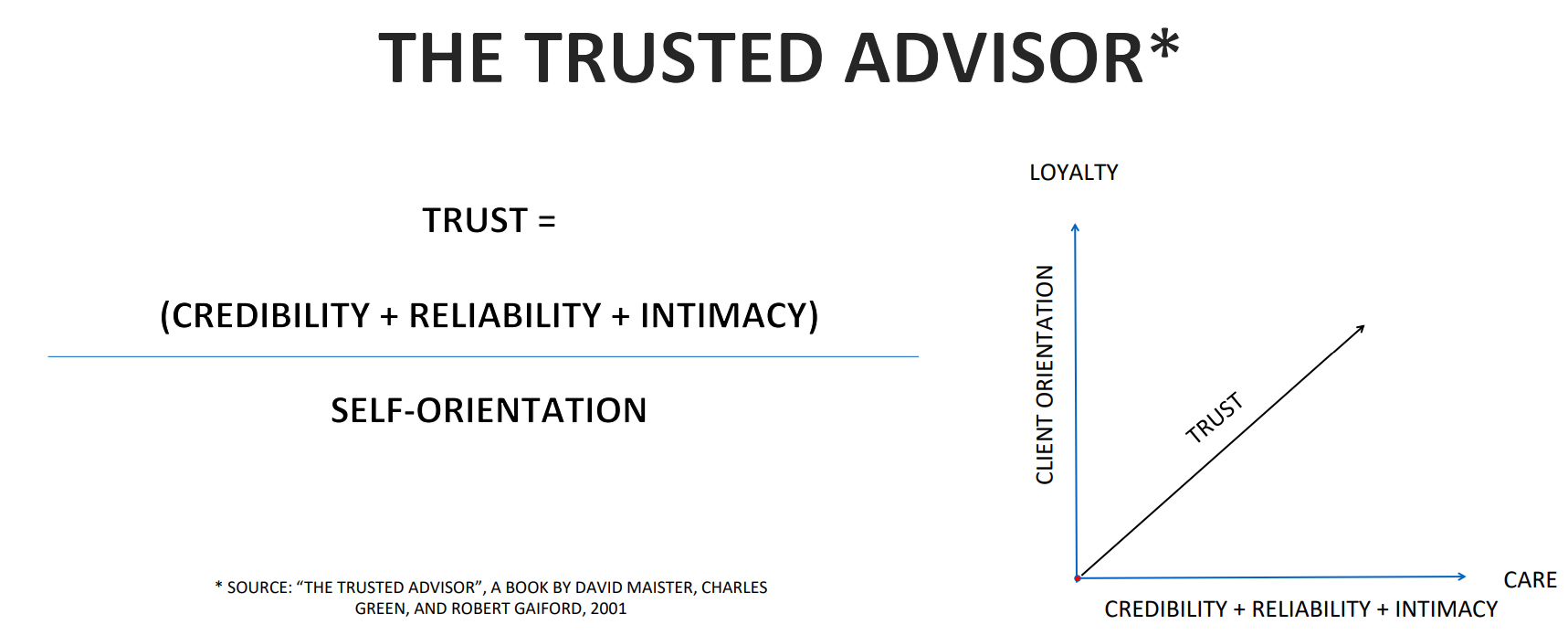A Math Nerd's Evaluation of Blaine's Reputation White Paper
Posted by Tyler Kirkland, AIF®, PPC®, Director of Business Development and Client Engagement on August 31, 2018

Warning #1: This post is a little different from my typical playful delivery.
I recently sat in on a webinar called "How much is your reputation worth?" It was presented by Scott Revare, AIF®, managing director with Fi360 and Blaine F. Aikin, AIFA®, CFA, CFP®, executive chairman with Fi360 and CEFEX.
During the webinar, Blaine presented a slide that featured an equation for trust, sourced from The Trusted Advisor, a book by David Maister, Charles Green, and Robert Gaiford, 2001.
I AM A NERD!
The moment I saw the following slide, I knew I wanted to write about it!

Warning #2: If you don’t enjoy math to some degree, you may want to stop reading at this point. There are plenty of posts out there that you will enjoy a lot more!
The Variables
The trust equation tells us that one’s level of trust is a function of ones: Credibility, Reliability, Intimacy and Self-Orientation.
Let’s break down the variables, shall we?
- Credibility is the quality or power of inspiring belief. One can be credible or not credible, but when it come to the idea of credibility, we can establish that credibility itself, cannot be a negative value. Further, someone can have zero credibility.
-
Reliability can be defined as the quality or state of being reliable…. -_- As an aside, I hate when a definition includes the root word. Apparently, Merriam-Webster does not share my frustration. Let’s go with definition number 2. Reliability is the extent to which an experiment, test, or measuring procedure yields the same results on repeated trials. Better! By applying similar logic as we did to Credibility, we see that someone is either reliable or un reliable, but the idea of reliability cannot be a negative value… And as sure as you are living, you know someone who has 0 reliability.
-
Intimacy the state of being intimate… really? Intimacy is something of a personal or private nature. I am sure you know what’s coming next. One can be intimate or not intimate but intimacy cannot exist as a negative value.
-
Self-Orientation This definition is tricky as it doesn’t exist in the M-W Dictionary, so we must derive it. Easy, right?!
-
Self - the union of elements (such as body, emotions, thoughts, and sensations) that constitute the individuality and identity of a person
-
Orientation - a usually general or lasting direction of thought, inclination, or interest
-
Thus, Self-Orientation is focusing one’s thoughts, inclinations or interests on their typical character and behavior. We will dig further into this variable, as we look at it relative to trust.
-
The Equations
Now that we have an understanding of the variables, we can take a stab at an analysis of the Trust Equation.
Trust = (Credibility + Reliability + Intimacy) / Self-Orientation
What I find most interesting about this equation is what can be derived by applying a simple math concept.
The Limits
I think it is amazing that mathematically you can model concepts that are obvious or inferred in “real life."
For example:
Mathematically we see that as one focusses more on oneself, the trust that has been established will head towards 0.
The fastest way to destroy trust is to focus solely on oneself.
On the other hand, with Self-Orientation being in the denominator of the Trust Equation, one cannot be completely selfless (Self-orientation ≠ 0). This makes sense as one who does not care about himself will fail to exist and therefore eliminate the potential of trust.
In other words, if one has no Self-Orientation, there can exist no trust. What happens if we approach zero Self-Orientation from a high level of Self-Orientation?
We see Trust growing towards infinity by multiple of one’s Credibility + Reliability + Intimacy but to infinity, none the less. BUT, Self-Orientation must exist (Self-orientation ≠ 0) in order for Trust to exist. This paradox speaks to the need of a standard which focuses on trust… sound familiar?
The Root
The root of an equation occurs when equality occurs. In plan terms, when will one’s level of trust equal their (Credibility + Reliability + Intimacy) / Self-Orientation?
We have established that Self-orientation ≠ 0. This implies that the only way equality can occur is if Credibility + Reliability + Intimacy = Trust. The only time this can occur is if one is not credible, not reliable and has no level of intimacy. When these variables are equal to zero, there will be No Trust.
Trust = (0+0+0) / Self-Orientation = 0 -> No Trust
Conclusion: For Fiduciaries, trust is a must!
If one is a fiduciary, trust must exist as an investment fiduciary stands in a special relationship of trust, confidence, and/or legal responsibility.
(Credibility + Reliability + Intimacy) / Self-Orientation > 0
Since Self-Orientation must be greater than 0, we can also imply...
Credibility + Reliability + Intimacy > 0
...for trust to be established.
Although the Trust Equation has no Maxima, and continues towards infinity, it gets there faster when all of the following are true, as well.
Credibility > 0
Reliability > 0
Intimacy > 0
Your ability to inspire belief, your showing up and your relationships will build trust. Your motives have the ability to destroy it, rapidly if misplaced.
What if your reputation were the vehicle by which trust was transferred between people… Someone should model THAT equation.





